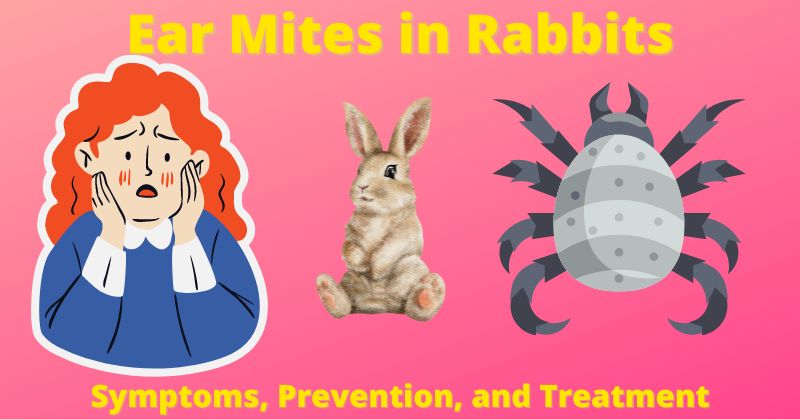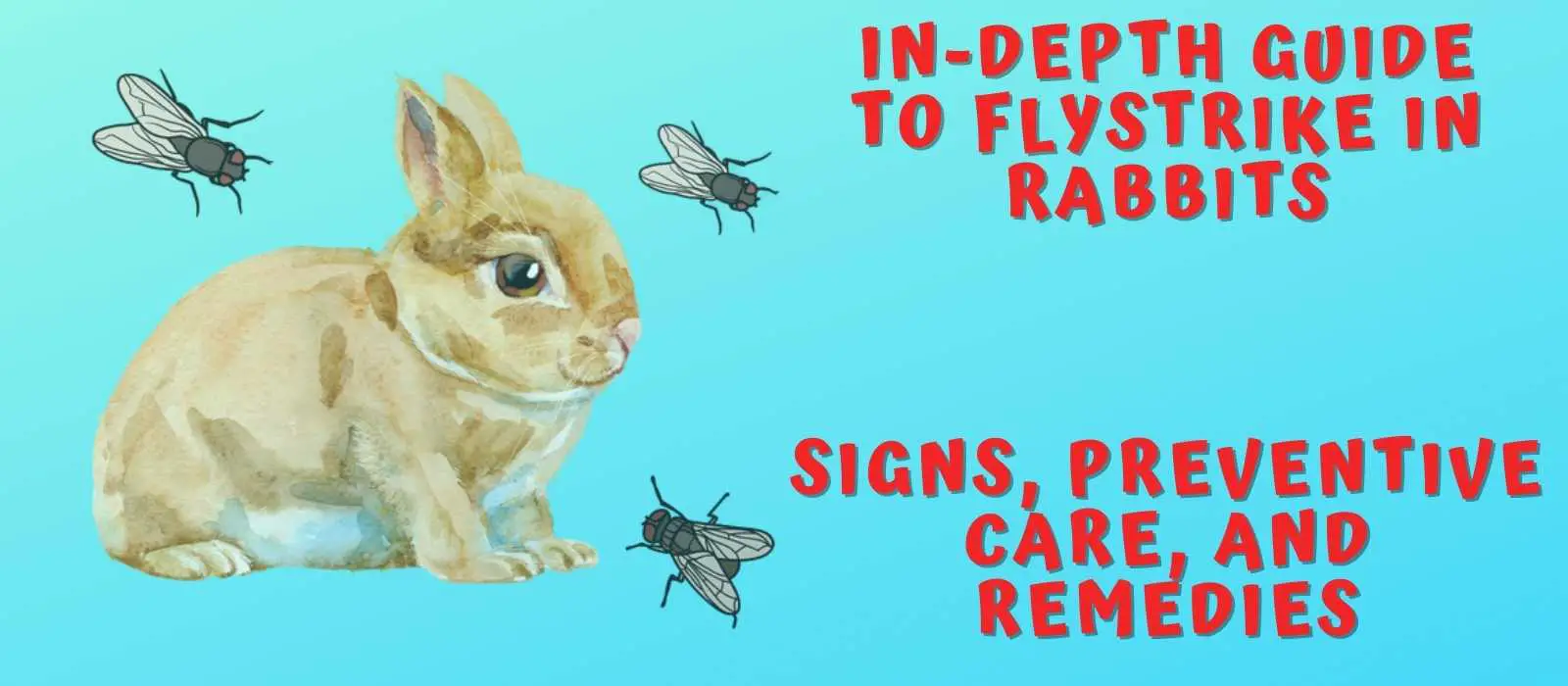Introduction: Ear Mites in Rabbits
Psoroptes cuniculi commonly termed ear mites in rabbits can infest your pet rabbit. Overlooking its symptoms at the early stage can lead to diseases like a canker sore and irritate your cutie dramatically. But the relieving fact is that diagnosing and treating this parasitic problem is uncomplicated.
Here is everything you need to know about ear mites in rabbits.
What are Ear Mites in Rabbits?
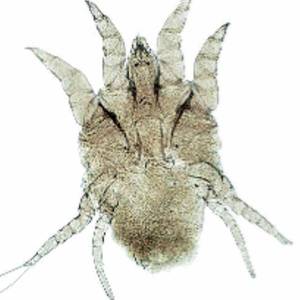
Ear mite or Psoroptes cuniculi is an oval-shaped parasite that lives in the ear pinnae of animals, devouring lymphatic fluid and ear wax of the host.
Eventually, the pet rabbit starts to bleed by scratching its head and ear due to extreme irritation. The musky parasite also consumes the blood oozing out of the infested area.
It generally infests one ear of the pet. But if not treated at the early stage, infestation spreads to both ears and the surrounding parts of the ears, such as the neck, head, paws, and ventral abdomen.
This parasite is bigger enough to see with the naked eye. But since they hide in the ear canal, it is difficult to identify the mites without thorough checking. Within 21 days of life-cycle, it invades deeper to the ear pinnae and lays eggs there.
Symptoms of Ear Mites Infestation in Rabbits
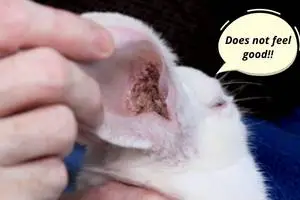
You can observe different symptoms at various stages of ear mite infestation.
- Scratching Ears and Shaking Head
At the initial stage, you can observe your small bunny terribly scratching the affected area and shaking its head frequently.
- Clingy Hairs
Generally, a healthy rabbit possesses soft and lustrous fur. But overran hairs will look dull and clingy due to the sticky discharge.
- Injury from Excessive Scratching
Saliva and feces of ear mites are sticky and create extreme irritation in the infected area. Within a couple of days of infestation, the rabbit will start bleeding due to non-stop scratching.
- Earwax-like Scales
Eventually, you can notice yellow-grey build-up within the ear canal and inner earlobes. This thick crusting forms from mites’ feces, saliva, rabbit skin cells, and blood.
- Fur Loss in the Earlobes and Inflammation
Simultaneously, alopecia and inflamed ears can be observed.
- Droopy Ears
Within the next few days, the wax-like build-up covers the entire earlobes. The crusting becomes too heavy that it becomes impossible for rabbits to lift their ears. Thus, in the extreme stage of infestation, you can see your pet with droopy ears.
- Tilted Head
If this parasitic problem is not treated for a long time, the infestation reaches the inner ear. It may affect the vestibular tract causing extreme irritation and failing to maintain the upright head posture. You may notice your bunny leaning her head at a 90° angle.
- Weight Loss
Besides these visible symptoms, you can notice a loss of appetite and reduced weight in your dwarf pet.
Pet parents should not wait for such an intense level of infestation as it is excruciating for animals. Once you observe your bunny is scratching their ears often, check him thoroughly and consult a veterinarian immediately.
How to Check and Identify Mites
Upon noticing the symptoms of ear mites in rabbits, check her ears and surrounding areas. If you find a black-colored oval-shaped parasite with suckers within your bunny’s ears and fur, be sure your pet is infested by this ugly mite.
However, during the early days of infestation, they cannot be seen as they reside in the ear canal. In that case, it is better to consult a vet for an intensive checkup without waiting for some visual symptoms to appear. The diagnostic process includes the following steps.
Complete Check-up
The vet checks your bunny from head to tail. It pinpoints all health issues of your bunny besides ear mite infestation. Sometimes the problem gets severe within a few days. This can be possible due to a sustained bacterial infection.
Skin Fleck Test
Vets carefully strip off a small portion of crust fleck and examine it with a microscope. If there are any mites or their eggs, they will be identified easily.
Test Using Otoscope
Even if you can’t see those ugly mites in the ear pinnae of your pet, they won’t be able to hide in the beam of the otoscope. Vets use this tool to examine the deepest part of the ear canal and if your bunny has Psoroptes cuniculi, it will be visible as small white blobs.
Treatment for ear mites in rabbits
The treatment procedure for ear mites in rabbits doesn’t involve any painful surgery or intensive care. Heeding a few things and imparting medicines in the prescribed manner is enough to make your pet healthy and free from all irritations within a few weeks.
Seek Expert Advice before Giving Any Medicine
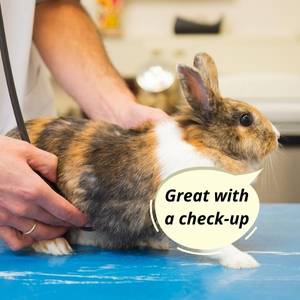
While giving any medication to your small pet for treating ear mites, don’t forget to consult a veterinarian first. He will conduct a thorough health checkup to make sure the problem is caused by Psoroptes cuniculi.
Don’t preempt and apply over-the-counter medicines relying on the symptoms, as bunnies, especially the lop-eared ones may contract several ear infections. This can confuse pet parents as signs of such diseases are indistinguishable from the mite infestation in the earhole.
Ear scratching or build-up of wax-like debris may be the consequence of bacterial infections, trauma, or tumor. Thus, for safe treatment and faster recovery, it is necessary to identify the exact problem.
Apply Proper Dosing
The treatment procedure primarily involves smearing medicines on rabbits to kill mites. It can be given by oral ingestion or topical application.
Ivermectin anti-parasite drugs are highly recommended for curing mite infestation. It generally comes in form of a solution that you need to inject into your pet rabbit. Once it penetrates through the blood vessels and circulates throughout the body, it starts killing mites.
However, these medicines are effective for adult mites only and can’t kill eggs. Thus, one dose is not enough to get rid of this infestation forever. Repeat the dosage fortnightly thrice. This way, all hatched parasites will croak and can’t lay eggs again.
Besides ivermectin, the vet can also prescribe pain relief and anti-inflammatory drugs to reduce soreness and itchiness. If your bunny suffers from a simultaneous bacterial infection, a few doses of anti-bacterial medicines will be added.
Don’t Try to Peel off Crust
Bunnies infested with ear mites develop thick wax-like crusting within a short span. It looks very dirty and ugly. But never remove such scales forcibly. Any forceful attempt to clear the wax can cause flaying of the bunny’s ears and bleeding. Within 10 days of injecting or ingesting ivermectin, crusts will fall off automatically.
Treat All Pets in the House
The ear mite is extremely contagious and within a few days, it can infest all pets in the house. Thus, once you identify symptoms of this disease in your bunny, take your all pets to the vet for a thorough check-up.
Clean the Rabbit Environment
Besides giving proper medication, rigorously clean your bunny’s environment to prevent reinfection. This contagious parasite and its eggs may topple over from the host’s body and live in the surrounding areas for 21 days (maybe for a longer time if the weather or the area is moist). Thus, you need to disinfect everything your pet comes into contact with, such as bedding, litter box, toys, carpets, etc.
- Create temporary bedding with newspapers for your bunny and keep changing it every day.
- Clean the litter box frequently.
- Replace the bedding of the old enclosure and use disinfectant to kill mites.
- Keep your bunny at a distance from the treated area unless the residue of the disinfectant gets evaporated. It can be toxic for pets.
- Don’t opt for wet cleaning, as it will be beneficial for mites to live in a moist area.
- Use strong chemicals to clean the wooden hutch or replace it completely, as it is difficult to disinfect this material.
Preventive Measures to Keep Your Bunny Safe from Ear Mites
You can prevent ear mite infestation or reinfestation following a few safety measures.
- While adopting a new rabbit, keep it in quarantine for at least 6 weeks to check whether it is carrying the disease
- Thoroughly examine its ears once a week to identify the infection at the early stage
- In case you have multiple pets in your house, keep the affected one separate from the rest to prevent spreading.
- Prevent your bunny from going backyard or garden as it increases the chances of contracting ear mites infestation.
- Clean your house, especially the rabbit enclosure frequently.
Wrap Up,
There is no need to worry if your cutie has an ear mites infestation. Early detection and proper treatment are necessary to relieve the little creature from discomfort and severe pain. With the right measures, your rabbit can overcome the dilemma in a few days.
I hope you found this guide on ear mites in bunnies helpful. If you need advice for ear mites treatment and medication, visit a local vet immediately.

